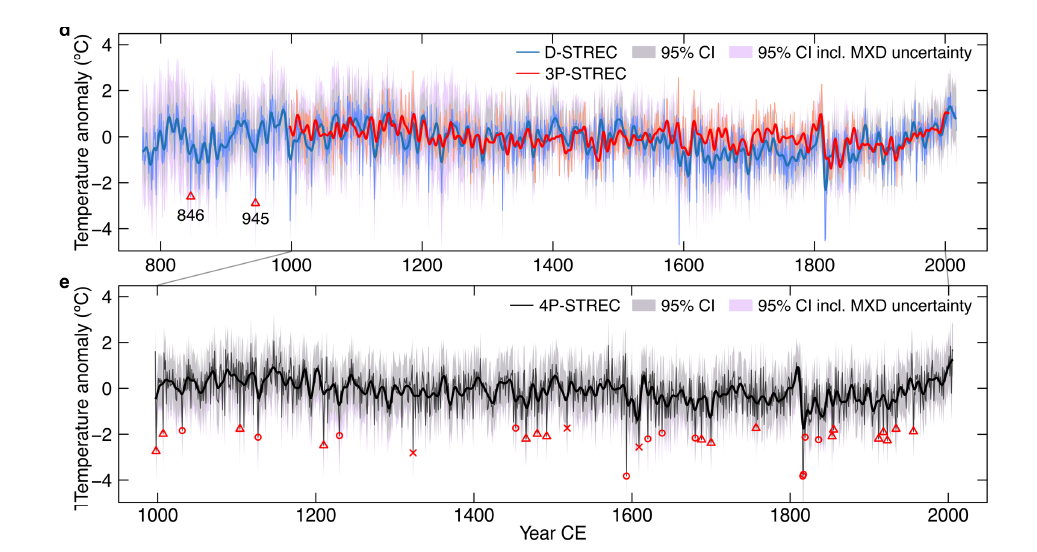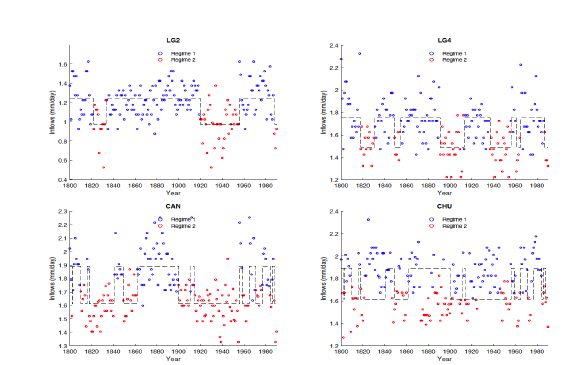Risk of persistent drought in the hydroelectric reservoirs of Quebec-Labrador: a millennial perspective
This approach will allow Canadian hydropower producers to better assess their exposure to persistent droughts while benefiting from a better understanding of the long-term hydrological variability in the production territory.
Project details
Principal(s) investigator(s)

Context
On a territory like the Quebec Labrador peninsula, where most of the electricity production comes from hydropower, just a few number of consecutive years that are drier than usual can threaten energy security, which is an essential condition for economic growth. At present, the short duration of hydro-meteorological observations and the inability of climate models to adequately represent the characteristics of the natural inter-decadal variability limit our capacity to estimate the risk of drought for this territory.
Faced with these challenges, the PERSISTENCE project, based on a partnership between academia, Ouranos and the hydroelectric sector (Hydro-Québec and Manitoba Hydro), proposes to utilize the information contained in the millennial-scale hydrological time series collected from natural indicators (tree rings, sediment sequences) to improve the estimation of the current and future risk of persistent low runoff.
Objective(s)
-
Estimate the risk of persistent drought (PD) in the heart of the main hydroelectric production area in Quebec-Labrador by combining the variabilities of hydrological reconstructions with future trends outlined by climate models.
Methodology
-
Development of millennial chronologies of tree rings and lake sediments of large hydroelectric reservoirs: Bay James, the Labrador Sea and the Côte-Nord.
-
Reconstitution of the millennial variations of the annual inflows for each hydroelectric reservoir using high-resolution paleoclimatic indicators.
-
Modeling of the persistence in millennial hydrological time series with stationary and non-stationary time series models, followed by an estimate of the current risk of PD.
-
Production of the estimated future PD risk taking into account the impact of climate change on the hydrological regime and the representative persistence of the millennial variability.
Results
Millennial variations in summer temperatures
This project has made it possible to compile the most up-to-date data on millennial variations in summer temperatures in the Quebec-Labrador peninsula, using tree rings. The resulting regional portrait highlights two important aspects. First, recent (post-1850) warming has only been matched in history during the medieval climatic period. Second, it demonstrates the important role played by volcanic eruptions, particularly tropical eruptions, in the persistence of cold episodes since 1000 CE.

Figure 1. New reconstruction of summer temperatures (MJJA) based on maximum latewood densities (DSTREC). The chronology is compared to the multi-indicator reconstruction developed by Gennaretti et al. (2017) (3PSTREC, top). New reconstruction emerging from the fusion of D-STREC and 3P-STREC (4P-STREC, bottom). Volcanic eruptions are indicated by red symbols. Taken from Wang et al., in prep.
Millennial variations in regional hydrology
The project updated the first millennial hydrological reconstructions, which were based on sedimentary sequences at Grand Lake. These reconstructions of the inflows of the Naskaupi River (main tributary of Grand Lake) date back to 497 CE and confirm that recent variations are within the limits of the historical variability of the last 1500 years, both in terms of maximum flow and average flow.
Modelling of persistence
An approach featuring the statistical modelling of persistence was developed as part of the project. This approach segments the time series into distinct regimes (Figure 2, example of the LG2, LG4, Caniapiscau and Churchill Falls basins) and makes it possible to predict the risk of episodes of persistent low flow. When reconstructed data is fed into this modelling approach, the uncertainty associated with the prediction of episodes of persistent low flow is reduced. This shows the added value that natural archives can have in forecasting.

Figure 2: Segmentation en régimes "humides" (bleu) et "secs" (rouge) des apports reconstitués (1800 CE) aux centrales LG2, LG4, Caniapiscau-Brisay (CAN) et Churchill Falls (CHU).
This project generated new hydro-climatic reconstructions that are unique in eastern North America and extremely rare on the scale of the northern hemisphere. It is important to recall the fragmentary nature of the knowledge of millennial variations at the outset of the project, in 2016, when there were only two datasets available in the study region: the reconstruction by Gennaretti et al. (2014) from the widths of tree rings, and the reconstruction by Naulier et al. (2015) from oxygen isotopes (9-year resolution). The new series of maximum latewood densities compiled as part of the PERSISTANCE project are a valuable addition to the existing temperature reconstructions.
Benefits for adaptation
Benefits for adaptation
Hydroelectricity producers in Eastern Canada now have an up-to-date portrait of hydro-climatic variability over long time scales as well as a robust approach to using this history to improve predictability.
Producers are now better equipped to deal with fluctuations in supply resulting from natural climate variability. This should ultimately provide a stable foundation on which producers can rely to in managing and anticipating fluctuations in water resources on multi-year to ten-year scales.
Scientific publications
Funding



Other participants
-
Commission Géologique du Canada
-
Institut de recherche d’Hydro-Québec (IREQ)
-
Institut National de recherche scientifique (INRS-ETE)
-
Manitoba Hydro
-
Université du Québec à Rimouski (UQAR)
-
Université d’Aix-Marseille
-
Université Laval